Reflective Paper: Global Trade Operations Course Experience
VerifiedAdded on 2022/03/25
|6
|1440
|12
Journal and Reflective Writing
AI Summary
This reflective paper offers a student's perspective on the Global Trade Operations (GTO) course, detailing their initial expectations, learning outcomes, and skill development. The student discusses the course's impact on their understanding of globalization, international trade operations, and trade policies. They highlight key concepts such as comparative and competitive advantages, exploring models by Ricardian, Heckscher-Ohlin, and Porter. The paper also reflects on practical applications through assignments analyzing Gwangyang Port and Thailand's trade capacity. The student emphasizes the course's influence on their analytical, critical thinking skills, and career development, particularly in relation to Porter's model of competitive advantage. The paper concludes with a reflection on the course's benefits and its relevance to their future career plans.
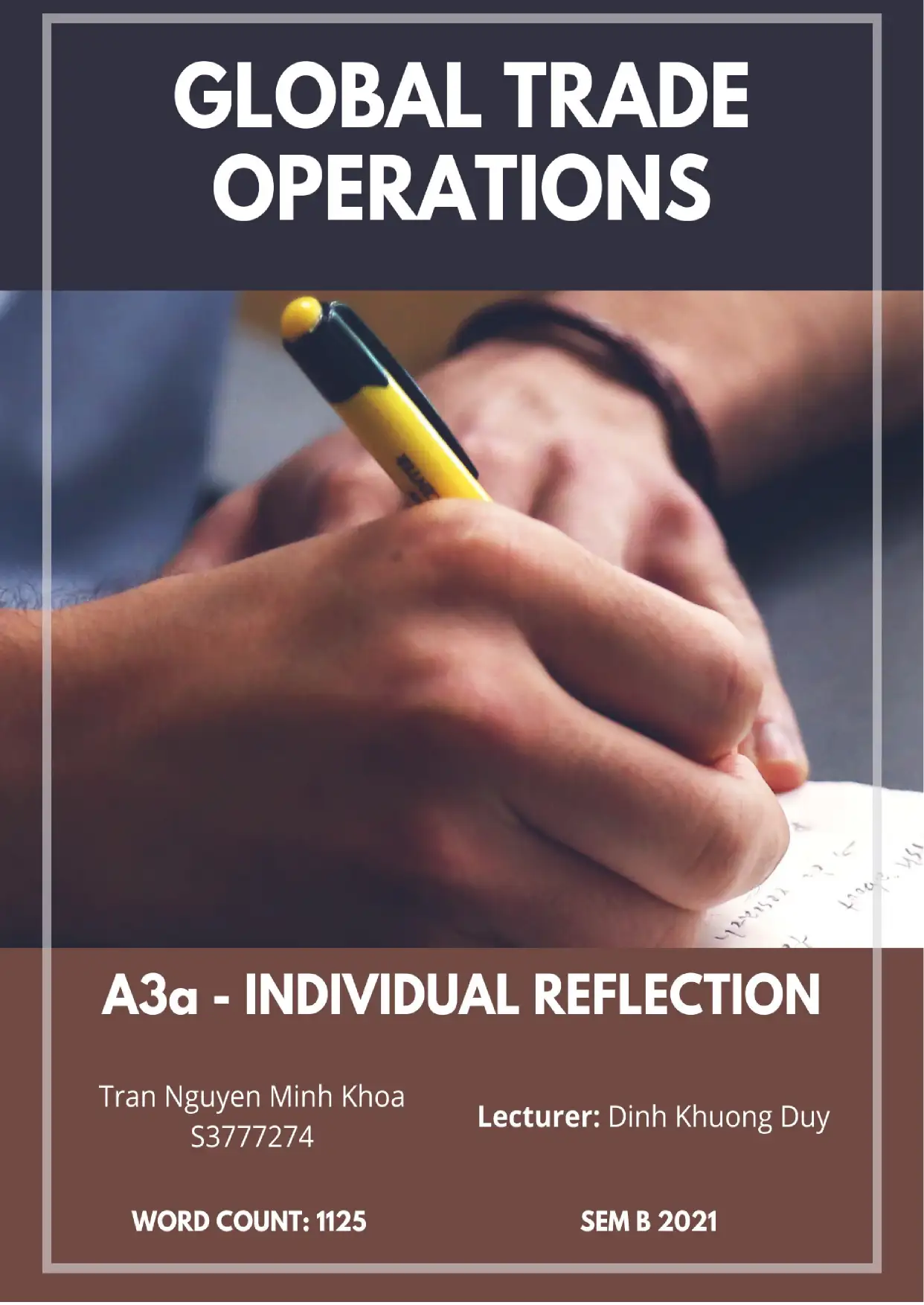
Paraphrase This Document
Need a fresh take? Get an instant paraphrase of this document with our AI Paraphraser
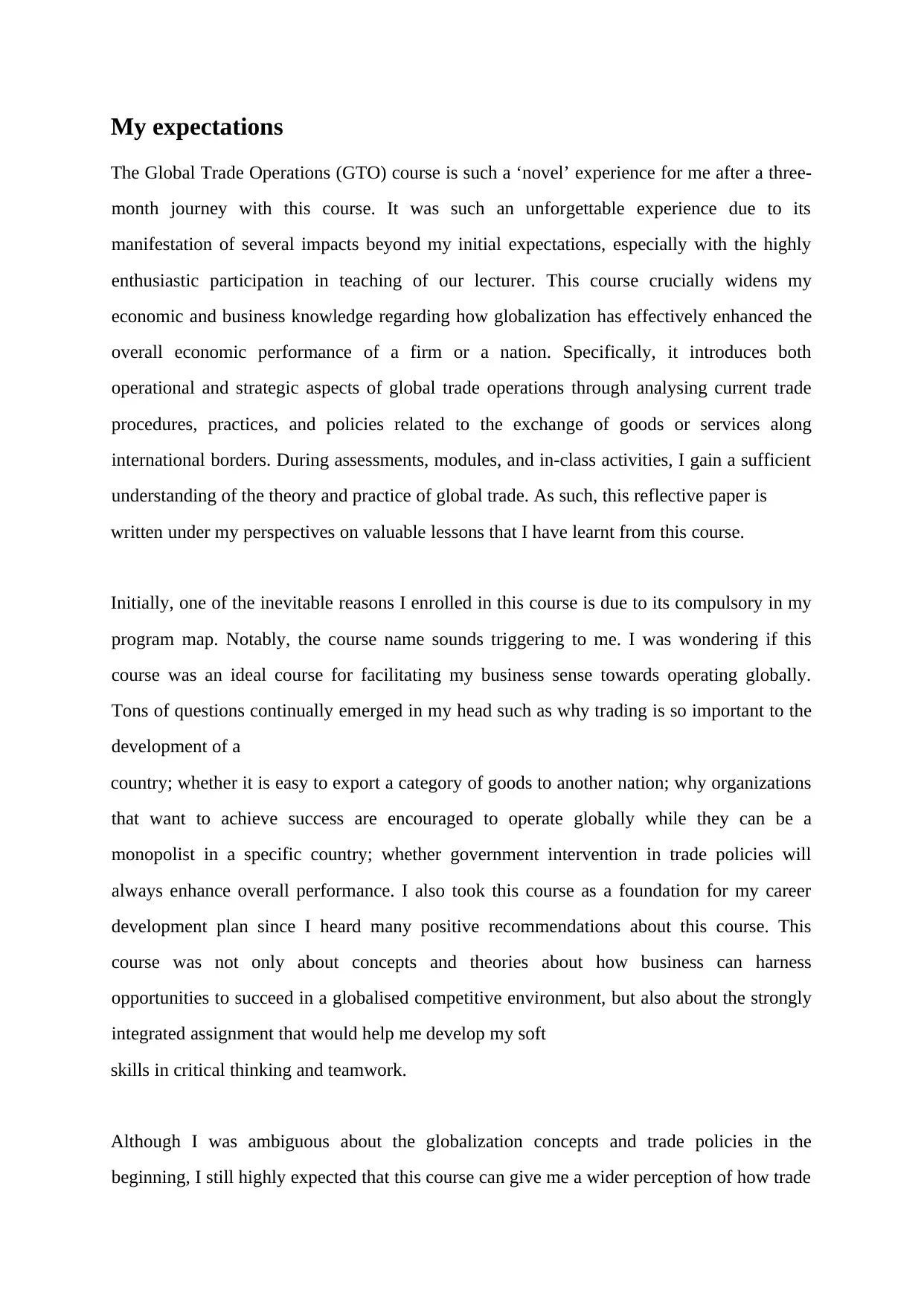
My expectations
The Global Trade Operations (GTO) course is such a ‘novel’ experience for me after a three-
month journey with this course. It was such an unforgettable experience due to its
manifestation of several impacts beyond my initial expectations, especially with the highly
enthusiastic participation in teaching of our lecturer. This course crucially widens my
economic and business knowledge regarding how globalization has effectively enhanced the
overall economic performance of a firm or a nation. Specifically, it introduces both
operational and strategic aspects of global trade operations through analysing current trade
procedures, practices, and policies related to the exchange of goods or services along
international borders. During assessments, modules, and in-class activities, I gain a sufficient
understanding of the theory and practice of global trade. As such, this reflective paper is
written under my perspectives on valuable lessons that I have learnt from this course.
Initially, one of the inevitable reasons I enrolled in this course is due to its compulsory in my
program map. Notably, the course name sounds triggering to me. I was wondering if this
course was an ideal course for facilitating my business sense towards operating globally.
Tons of questions continually emerged in my head such as why trading is so important to the
development of a
country; whether it is easy to export a category of goods to another nation; why organizations
that want to achieve success are encouraged to operate globally while they can be a
monopolist in a specific country; whether government intervention in trade policies will
always enhance overall performance. I also took this course as a foundation for my career
development plan since I heard many positive recommendations about this course. This
course was not only about concepts and theories about how business can harness
opportunities to succeed in a globalised competitive environment, but also about the strongly
integrated assignment that would help me develop my soft
skills in critical thinking and teamwork.
Although I was ambiguous about the globalization concepts and trade policies in the
beginning, I still highly expected that this course can give me a wider perception of how trade
The Global Trade Operations (GTO) course is such a ‘novel’ experience for me after a three-
month journey with this course. It was such an unforgettable experience due to its
manifestation of several impacts beyond my initial expectations, especially with the highly
enthusiastic participation in teaching of our lecturer. This course crucially widens my
economic and business knowledge regarding how globalization has effectively enhanced the
overall economic performance of a firm or a nation. Specifically, it introduces both
operational and strategic aspects of global trade operations through analysing current trade
procedures, practices, and policies related to the exchange of goods or services along
international borders. During assessments, modules, and in-class activities, I gain a sufficient
understanding of the theory and practice of global trade. As such, this reflective paper is
written under my perspectives on valuable lessons that I have learnt from this course.
Initially, one of the inevitable reasons I enrolled in this course is due to its compulsory in my
program map. Notably, the course name sounds triggering to me. I was wondering if this
course was an ideal course for facilitating my business sense towards operating globally.
Tons of questions continually emerged in my head such as why trading is so important to the
development of a
country; whether it is easy to export a category of goods to another nation; why organizations
that want to achieve success are encouraged to operate globally while they can be a
monopolist in a specific country; whether government intervention in trade policies will
always enhance overall performance. I also took this course as a foundation for my career
development plan since I heard many positive recommendations about this course. This
course was not only about concepts and theories about how business can harness
opportunities to succeed in a globalised competitive environment, but also about the strongly
integrated assignment that would help me develop my soft
skills in critical thinking and teamwork.
Although I was ambiguous about the globalization concepts and trade policies in the
beginning, I still highly expected that this course can give me a wider perception of how trade
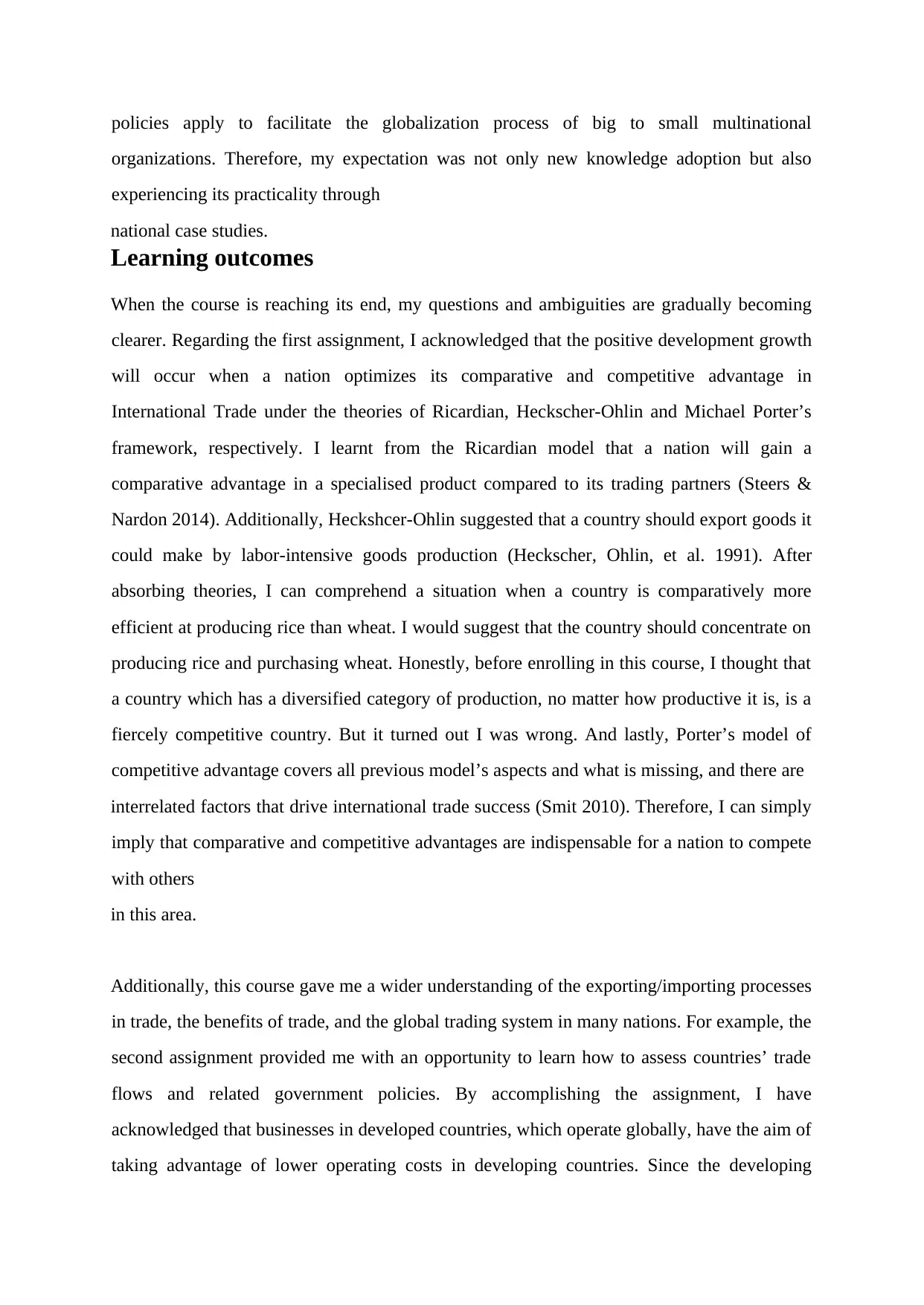
policies apply to facilitate the globalization process of big to small multinational
organizations. Therefore, my expectation was not only new knowledge adoption but also
experiencing its practicality through
national case studies.
Learning outcomes
When the course is reaching its end, my questions and ambiguities are gradually becoming
clearer. Regarding the first assignment, I acknowledged that the positive development growth
will occur when a nation optimizes its comparative and competitive advantage in
International Trade under the theories of Ricardian, Heckscher-Ohlin and Michael Porter’s
framework, respectively. I learnt from the Ricardian model that a nation will gain a
comparative advantage in a specialised product compared to its trading partners (Steers &
Nardon 2014). Additionally, Heckshcer-Ohlin suggested that a country should export goods it
could make by labor-intensive goods production (Heckscher, Ohlin, et al. 1991). After
absorbing theories, I can comprehend a situation when a country is comparatively more
efficient at producing rice than wheat. I would suggest that the country should concentrate on
producing rice and purchasing wheat. Honestly, before enrolling in this course, I thought that
a country which has a diversified category of production, no matter how productive it is, is a
fiercely competitive country. But it turned out I was wrong. And lastly, Porter’s model of
competitive advantage covers all previous model’s aspects and what is missing, and there are
interrelated factors that drive international trade success (Smit 2010). Therefore, I can simply
imply that comparative and competitive advantages are indispensable for a nation to compete
with others
in this area.
Additionally, this course gave me a wider understanding of the exporting/importing processes
in trade, the benefits of trade, and the global trading system in many nations. For example, the
second assignment provided me with an opportunity to learn how to assess countries’ trade
flows and related government policies. By accomplishing the assignment, I have
acknowledged that businesses in developed countries, which operate globally, have the aim of
taking advantage of lower operating costs in developing countries. Since the developing
organizations. Therefore, my expectation was not only new knowledge adoption but also
experiencing its practicality through
national case studies.
Learning outcomes
When the course is reaching its end, my questions and ambiguities are gradually becoming
clearer. Regarding the first assignment, I acknowledged that the positive development growth
will occur when a nation optimizes its comparative and competitive advantage in
International Trade under the theories of Ricardian, Heckscher-Ohlin and Michael Porter’s
framework, respectively. I learnt from the Ricardian model that a nation will gain a
comparative advantage in a specialised product compared to its trading partners (Steers &
Nardon 2014). Additionally, Heckshcer-Ohlin suggested that a country should export goods it
could make by labor-intensive goods production (Heckscher, Ohlin, et al. 1991). After
absorbing theories, I can comprehend a situation when a country is comparatively more
efficient at producing rice than wheat. I would suggest that the country should concentrate on
producing rice and purchasing wheat. Honestly, before enrolling in this course, I thought that
a country which has a diversified category of production, no matter how productive it is, is a
fiercely competitive country. But it turned out I was wrong. And lastly, Porter’s model of
competitive advantage covers all previous model’s aspects and what is missing, and there are
interrelated factors that drive international trade success (Smit 2010). Therefore, I can simply
imply that comparative and competitive advantages are indispensable for a nation to compete
with others
in this area.
Additionally, this course gave me a wider understanding of the exporting/importing processes
in trade, the benefits of trade, and the global trading system in many nations. For example, the
second assignment provided me with an opportunity to learn how to assess countries’ trade
flows and related government policies. By accomplishing the assignment, I have
acknowledged that businesses in developed countries, which operate globally, have the aim of
taking advantage of lower operating costs in developing countries. Since the developing
⊘ This is a preview!⊘
Do you want full access?
Subscribe today to unlock all pages.

Trusted by 1+ million students worldwide
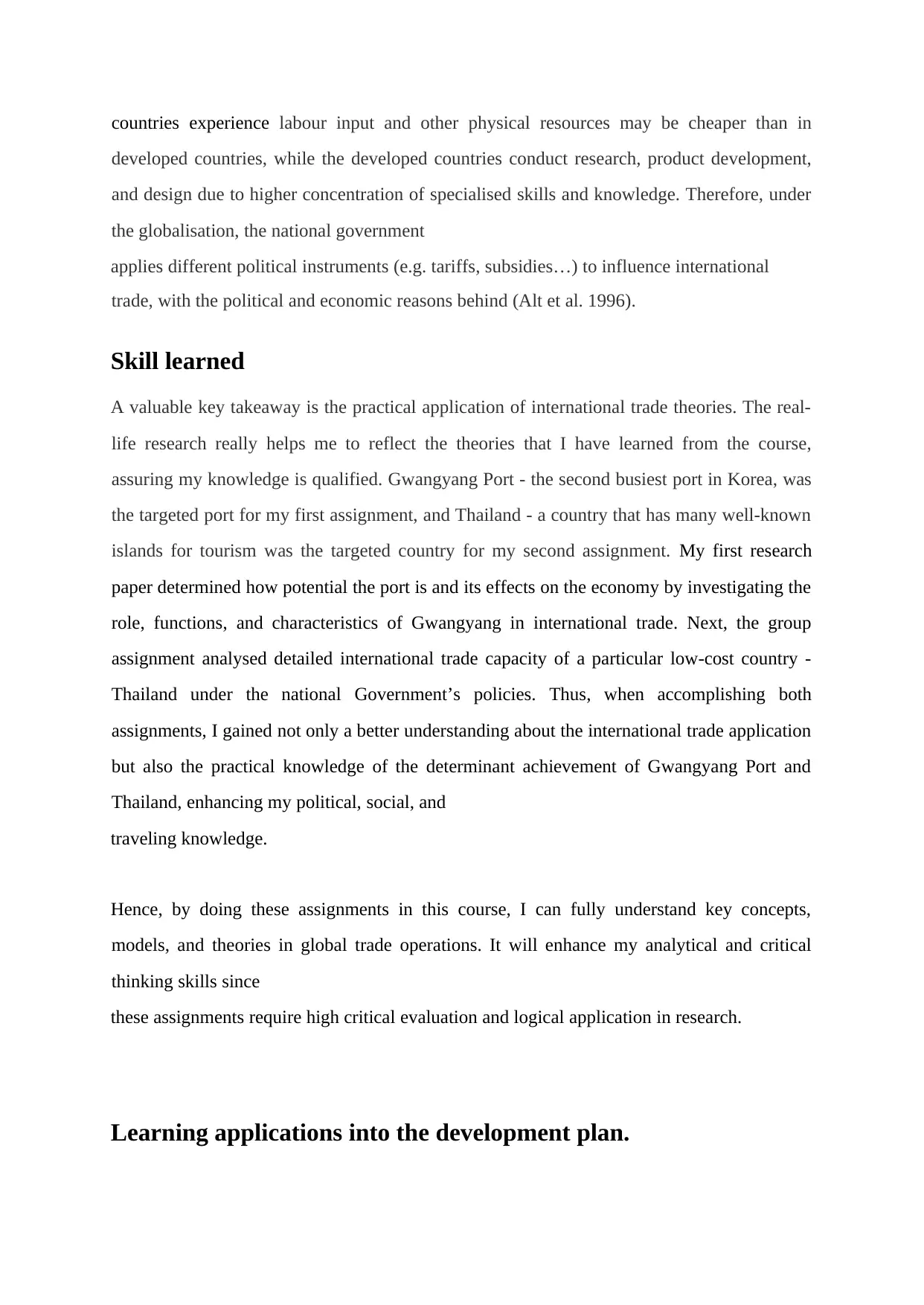
countries experience labour input and other physical resources may be cheaper than in
developed countries, while the developed countries conduct research, product development,
and design due to higher concentration of specialised skills and knowledge. Therefore, under
the globalisation, the national government
applies different political instruments (e.g. tariffs, subsidies…) to influence international
trade, with the political and economic reasons behind (Alt et al. 1996).
Skill learned
A valuable key takeaway is the practical application of international trade theories. The real-
life research really helps me to reflect the theories that I have learned from the course,
assuring my knowledge is qualified. Gwangyang Port - the second busiest port in Korea, was
the targeted port for my first assignment, and Thailand - a country that has many well-known
islands for tourism was the targeted country for my second assignment. My first research
paper determined how potential the port is and its effects on the economy by investigating the
role, functions, and characteristics of Gwangyang in international trade. Next, the group
assignment analysed detailed international trade capacity of a particular low-cost country -
Thailand under the national Government’s policies. Thus, when accomplishing both
assignments, I gained not only a better understanding about the international trade application
but also the practical knowledge of the determinant achievement of Gwangyang Port and
Thailand, enhancing my political, social, and
traveling knowledge.
Hence, by doing these assignments in this course, I can fully understand key concepts,
models, and theories in global trade operations. It will enhance my analytical and critical
thinking skills since
these assignments require high critical evaluation and logical application in research.
Learning applications into the development plan.
developed countries, while the developed countries conduct research, product development,
and design due to higher concentration of specialised skills and knowledge. Therefore, under
the globalisation, the national government
applies different political instruments (e.g. tariffs, subsidies…) to influence international
trade, with the political and economic reasons behind (Alt et al. 1996).
Skill learned
A valuable key takeaway is the practical application of international trade theories. The real-
life research really helps me to reflect the theories that I have learned from the course,
assuring my knowledge is qualified. Gwangyang Port - the second busiest port in Korea, was
the targeted port for my first assignment, and Thailand - a country that has many well-known
islands for tourism was the targeted country for my second assignment. My first research
paper determined how potential the port is and its effects on the economy by investigating the
role, functions, and characteristics of Gwangyang in international trade. Next, the group
assignment analysed detailed international trade capacity of a particular low-cost country -
Thailand under the national Government’s policies. Thus, when accomplishing both
assignments, I gained not only a better understanding about the international trade application
but also the practical knowledge of the determinant achievement of Gwangyang Port and
Thailand, enhancing my political, social, and
traveling knowledge.
Hence, by doing these assignments in this course, I can fully understand key concepts,
models, and theories in global trade operations. It will enhance my analytical and critical
thinking skills since
these assignments require high critical evaluation and logical application in research.
Learning applications into the development plan.
Paraphrase This Document
Need a fresh take? Get an instant paraphrase of this document with our AI Paraphraser
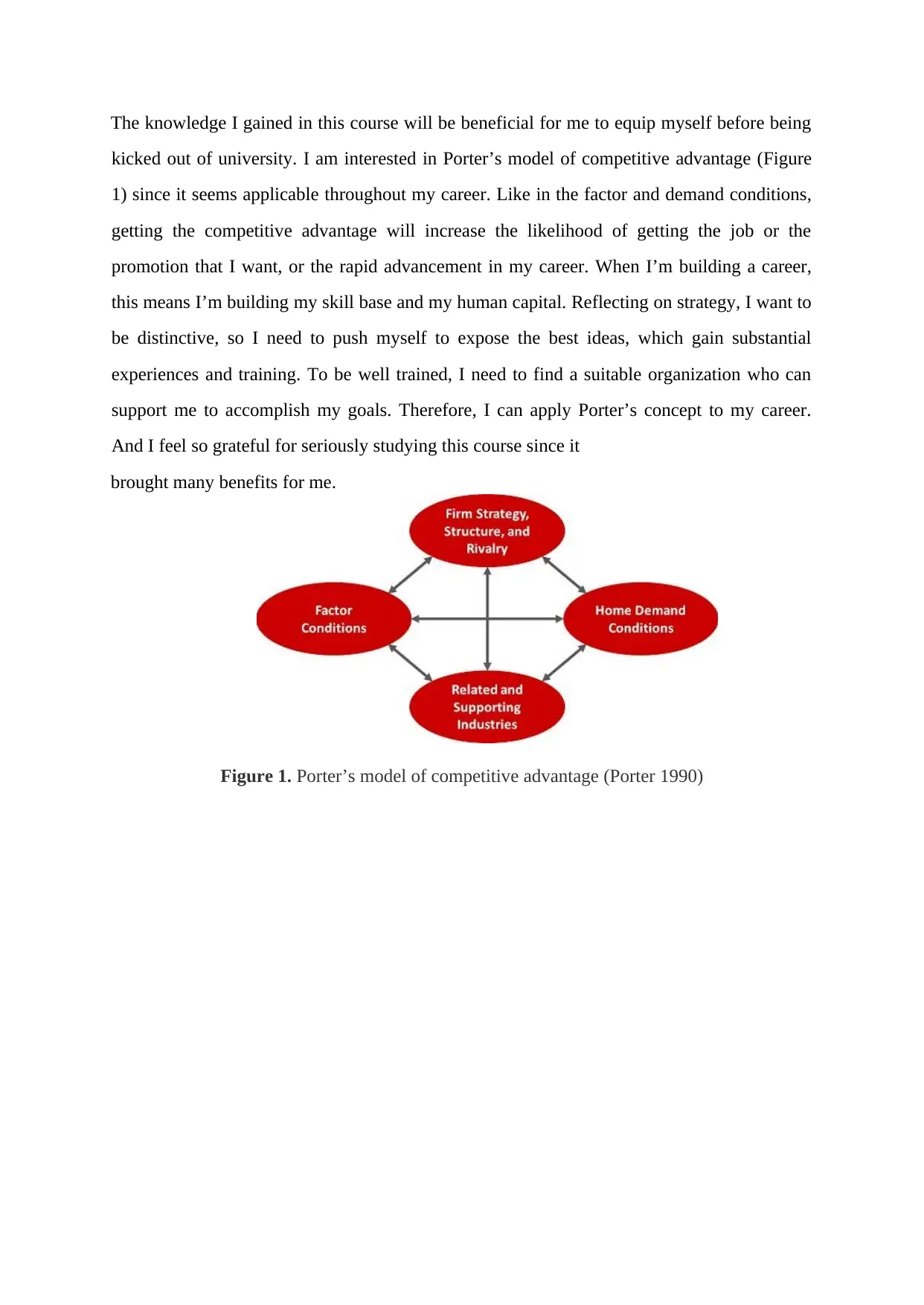
The knowledge I gained in this course will be beneficial for me to equip myself before being
kicked out of university. I am interested in Porter’s model of competitive advantage (Figure
1) since it seems applicable throughout my career. Like in the factor and demand conditions,
getting the competitive advantage will increase the likelihood of getting the job or the
promotion that I want, or the rapid advancement in my career. When I’m building a career,
this means I’m building my skill base and my human capital. Reflecting on strategy, I want to
be distinctive, so I need to push myself to expose the best ideas, which gain substantial
experiences and training. To be well trained, I need to find a suitable organization who can
support me to accomplish my goals. Therefore, I can apply Porter’s concept to my career.
And I feel so grateful for seriously studying this course since it
brought many benefits for me.
Figure 1. Porter’s model of competitive advantage (Porter 1990)
kicked out of university. I am interested in Porter’s model of competitive advantage (Figure
1) since it seems applicable throughout my career. Like in the factor and demand conditions,
getting the competitive advantage will increase the likelihood of getting the job or the
promotion that I want, or the rapid advancement in my career. When I’m building a career,
this means I’m building my skill base and my human capital. Reflecting on strategy, I want to
be distinctive, so I need to push myself to expose the best ideas, which gain substantial
experiences and training. To be well trained, I need to find a suitable organization who can
support me to accomplish my goals. Therefore, I can apply Porter’s concept to my career.
And I feel so grateful for seriously studying this course since it
brought many benefits for me.
Figure 1. Porter’s model of competitive advantage (Porter 1990)
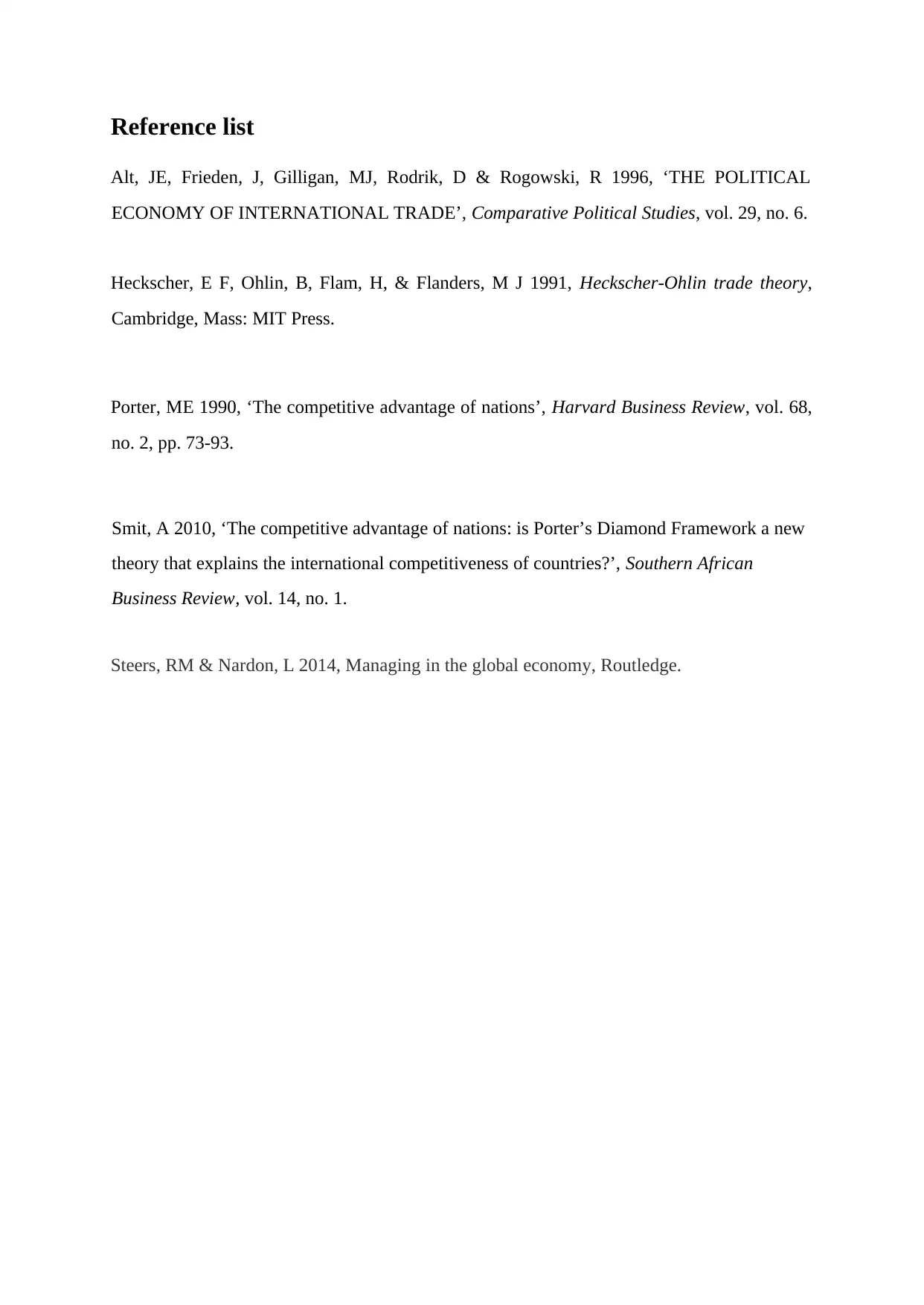
Reference list
Alt, JE, Frieden, J, Gilligan, MJ, Rodrik, D & Rogowski, R 1996, ‘THE POLITICAL
ECONOMY OF INTERNATIONAL TRADE’, Comparative Political Studies, vol. 29, no. 6.
Heckscher, E F, Ohlin, B, Flam, H, & Flanders, M J 1991, Heckscher-Ohlin trade theory,
Cambridge, Mass: MIT Press.
Porter, ME 1990, ‘The competitive advantage of nations’, Harvard Business Review, vol. 68,
no. 2, pp. 73-93.
Smit, A 2010, ‘The competitive advantage of nations: is Porter’s Diamond Framework a new
theory that explains the international competitiveness of countries?’, Southern African
Business Review, vol. 14, no. 1.
Steers, RM & Nardon, L 2014, Managing in the global economy, Routledge.
Alt, JE, Frieden, J, Gilligan, MJ, Rodrik, D & Rogowski, R 1996, ‘THE POLITICAL
ECONOMY OF INTERNATIONAL TRADE’, Comparative Political Studies, vol. 29, no. 6.
Heckscher, E F, Ohlin, B, Flam, H, & Flanders, M J 1991, Heckscher-Ohlin trade theory,
Cambridge, Mass: MIT Press.
Porter, ME 1990, ‘The competitive advantage of nations’, Harvard Business Review, vol. 68,
no. 2, pp. 73-93.
Smit, A 2010, ‘The competitive advantage of nations: is Porter’s Diamond Framework a new
theory that explains the international competitiveness of countries?’, Southern African
Business Review, vol. 14, no. 1.
Steers, RM & Nardon, L 2014, Managing in the global economy, Routledge.
⊘ This is a preview!⊘
Do you want full access?
Subscribe today to unlock all pages.

Trusted by 1+ million students worldwide
1 out of 6
Related Documents
Your All-in-One AI-Powered Toolkit for Academic Success.
+13062052269
info@desklib.com
Available 24*7 on WhatsApp / Email
![[object Object]](/_next/static/media/star-bottom.7253800d.svg)
Unlock your academic potential
Copyright © 2020–2025 A2Z Services. All Rights Reserved. Developed and managed by ZUCOL.





